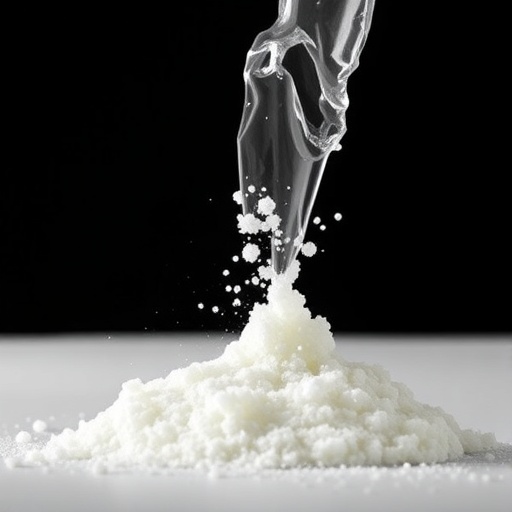In an unprecedented breakthrough that could reshape the future of sustainable materials science, researchers from Newcastle University and the University of Birmingham have unveiled a pioneering method to chemically disassemble one of the most resistant plastics known to science—polytetrafluoroethylene (PTFE), commercially recognized as Teflon®. This innovation not only promises an eco-friendly solution to the persistent problem of PTFE waste but also opens the door to transforming discarded materials into valuable chemical precursors using an energy-efficient mechanochemical process.
The material PTFE has long been hailed for its extraordinary chemical inertness and thermal stability, characteristics that have made it indispensable in innumerable applications including cookware, lubricants, and advanced electronics. However, these very properties have rendered PTFE exceptionally difficult to recycle. Conventional disposal methods, notably incineration, often release highly persistent environmental pollutants, specifically per- and polyfluoroalkyl substances (PFAS), which are notorious for their longevity and toxicity, raising grave environmental and public health concerns.
The research team confronted this exacting challenge by employing mechanochemistry—a green chemistry paradigm where mechanical force induces chemical transformations, circumventing the reliance on heat or solvents. Scientists utilized a ball mill apparatus wherein sodium metal and fragmented PTFE waste are subjected to continuous mechanical grinding at ambient temperature. This physical agitation facilitates a reductive cleavage of the notoriously robust carbon-fluorine bonds intrinsic to PTFE’s polymeric backbone.
This mechanistically novel reaction effectively liberates fluorine atoms from the polymer chains, converting them into sodium fluoride (NaF), a commonly used, chemically benign salt integral in toothpaste formulations for dental health. This process not only mitigates the production of hazardous fluorinated by-products but also recycles the fluorine into an easily utilizable chemical form, overturning former paradigms that viewed PTFE waste inherently as non-reclaimable.
More strikingly, the recovered sodium fluoride serves as a direct feedstock for the synthesis of high-value fluorine-containing compounds with substantial industrial and pharmaceutical relevance. Such compounds include diagnostic agents and specialty fine chemicals critical to modern medicine and technology, signifying an extended circular economy for fluorine that taps into previously inaccessible waste streams.
Advanced solid-state Nuclear Magnetic Resonance (NMR) spectroscopy, performed by experts at the University of Birmingham, played an essential role in substantiating the purity and conversion efficiency of this groundbreaking reaction. This powerful analytical technique allowed team members to observe the atomic-level transformation within the ball mill reaction mass, confirming the formation of clean sodium fluoride absent of detectable by-products—an exceptional testament to the reaction’s selectivity and sustainability.
The implications of this methodology extend beyond PTFE recycling. Given fluorine’s pivotal role in approximately one-third of emerging pharmaceuticals and its prevalence in various high-tech materials, this low-energy extraction and upcycling strategy signifies a paradigm shift in fluorine resource management. It portends reduced reliance on environmentally damaging fluorine mining and chemically intensive production processes, thereby significantly shrinking the global chemical industry’s carbon footprint.
The simplicity and accessibility of this reductive mechanochemical approach further accentuate its transformative potential. Utilizing inexpensive and readily available materials like sodium metal, the process requires no heating, toxic solvents, or elaborate purification steps, making it highly scalable and adaptable for industrial implementation. Moreover, it embodies the core principles of green chemistry by minimizing waste, conserving energy, and converting hazardous waste into valuable feedstocks.
This advance is not just a singular scientific accomplishment but a beacon indicating the growing maturity of mechanochemistry as a sustainable tool in materials recycling and chemical synthesis. The researchers anticipate that continued exploration along these lines will unlock new avenues for deconstructing and repurposing other recalcitrant fluorinated compounds and polymeric wastes, which have historically been considered intractable obstacles in environmental chemistry.
In contextualizing the environmental significance, this research explicitly addresses long-standing challenges where PTFE products, as they reach end-of-life stages, have traditionally accumulated in landfills or been incinerated with detrimental consequences. By reclaiming and refining fluorine from these wastes, this method circumvents the formation and dispersal of persistent organic pollutants, thereby contributing meaningfully to global efforts aimed at reducing chemical pollution and enhancing public health safeguards.
Fundamentally, this innovation exemplifies the power of interdisciplinary collaboration, weaving together expertise from polymer chemistry, solid-state nuclear magnetic resonance, and green chemical engineering. The convergence of innovative mechanochemical reaction design with sophisticated analytical verification embodies a template for future sustainability-driven scientific endeavors.
The publication of this research, titled “A Reductive Mechanochemical Approach Enabling Direct Upcycling of Fluoride from Polytetrafluoroethylene (PTFE) into Fine Chemicals,” in the Journal of the American Chemical Society, marks a watershed moment in the quest to harmonize industrial advancement with environmental stewardship. It lays the groundwork for a sustainable future in fluorine chemistry, ensuring that valuable elements are reclaimed from waste streams rather than irretrievably lost.
As the chemical industry and environmental regulators worldwide grapple with the downstream impacts of fluorinated polymers, this breakthrough offers a beacon of hope, signaling that even the most chemically persistent plastics can be strategically dismantled and converted into building blocks for materials essential to modern life. It is a small but pivotal step stirring momentum toward a truly circular economy in high-value chemical elements.
Subject of Research: Experimental study on the recycling and upcycling of fluorinated waste material (PTFE/Teflon®) via mechanochemistry.
Article Title: A Reductive Mechanochemical Approach Enabling Direct Upcycling of Fluoride from Polytetrafluoroethylene (PTFE) into Fine Chemicals
News Publication Date: 21-Oct-2025
Web References: http://dx.doi.org/10.1021/jacs.5c14052
Image Credits: Newcastle University
Keywords
Plastics, Polymer chemistry, Chemical compounds, Chemical processes, Thermal barrier coatings
Tags: eco-conscious manufacturing solutionseco-friendly recycling methodsenergy-efficient recycling techniquesgreen chemistry advancementsinnovative chemical disassemblymechanochemical process for plasticsPTFE waste managementreducing environmental pollutantssustainable materials sciencetackling PFAS pollutionTeflon recycling breakthroughtransforming plastic waste into valuable resources





